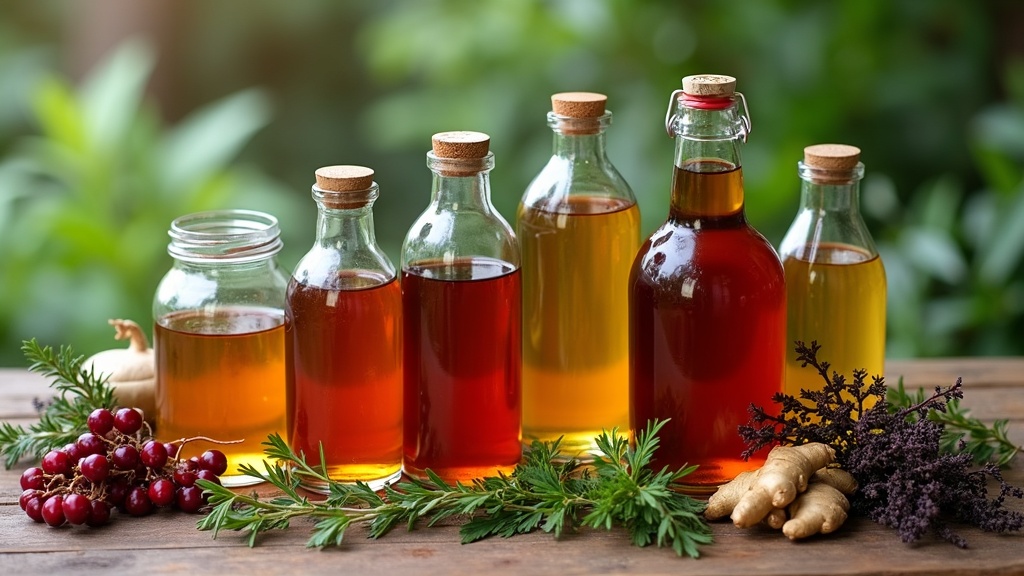DIY herbal syrups are pretty handy to have on hand, especially when cold season hits hard. I find that making these myself not only saves a bit of money, but also gives me control over exactly what goes into my remedies. The process is super straightforward—just a few fresh or dried herbs, water, and something sweet like honey or sugar. In this article, I’ll go through the basics of making your own herbal syrups for colds, including tips for customizing recipes, answers to some common questions, and a closer look at herbs that can help you get through sniffle season.

Why Try DIY Herbal Syrups for Colds?
When that first sneeze hits, I like having a homemade syrup ready. Store bought options often have extra ingredients I don’t want or need, like artificial colors, preservatives, or a ton of processed sugar. Making my own lets me focus on the herbs and plants that have been used for generations to soothe coughs, calm sore throats, and help the body bounce back.
Creating your own herbal syrup is also a way to personalize remedies based on what you or your family finds actually works. For example, if someone doesn’t like the taste of thyme, you can swap it out for something they do like. You can also adjust the sweetness level to your preference, making these syrups more palatable for kids or adults who are sensitive to strong flavors.
Understanding Herbal Infusions and Syrups
Before jumping into recipes, it helps to clear up what makes an infusion versus a syrup. An herbal infusion is basically like a strong tea, as the herbs are steeped in water to draw out their calming properties. Syrups go a step further by combining the strained infusion with a sweetener, which helps preserve the mixture and adds soothing action for irritated throats.
If you’re just looking for a quick way to get herbal benefits, a hot or cold infusion is all you need. But if you want something that keeps longer and is easy to dose by the spoonful, syrup is the way to go. I typically make both, but always keep a batch of syrup ready during winter months for its convenience and longer shelf life.
How to Make a Cold Herbal Infusion
Cold herbal infusions are a gentle way to get the benefits of herbs that might become bitter or lose potency with heat. They’re great for herbs like marshmallow root and certain flowers that are heat sensitive.
- Add herbs to a jar: Use about 1 tablespoon of dried herbs (or 2 tablespoons fresh) per cup of cold, filtered water.
- Pour in the cold water: Cover the herbs fully.
- Let steep overnight: Cover the jar and leave it at room temperature for 8 to 12 hours.
- Strain and enjoy: Use a fine mesh strainer, cheesecloth, or coffee filter to separate the herbs from the liquid.
- Drink or use in recipes: Cold infusions are soothing on their own and they can serve as the base for your homemade syrup.
This method is easy and especially nice for delicate herbs that might not like boiling water. Cold infusions can be sipped directly, or mixed with fruit juice for children who need a milder taste.
What’s the Best Formula to Make a Syrup for a Cough?
When making a syrup specifically for coughs, I stick with a ratio that’s easy to remember: 1 part herbal infusion to 1 part sweetener.
- 1 cup strong herbal infusion (from boiling or steeping your chosen herbs)
- 1 cup sweetener (usually honey, but maple syrup or raw sugar also work)
Combine your cooled, strained infusion with the sweetener in a saucepan. Warm gently on the stove; do not boil, especially if using honey, since high heat can break down its beneficial properties. Stir until fully dissolved, then pour into a cleaned glass jar or bottle. Stored in the fridge, homemade syrups can last up to three months.
This basic formula is flexible, letting you add more or less sweetener based on how thick or sweet you want the syrup to be. Some people like to add a dash of apple cider vinegar for extra zing and preservation benefits.
My Favorite Herbs for DIY Cold Syrups

Choosing the right herbs makes a difference. Some herbs help loosen mucus, others calm a scratchy throat, while a few can give your immune response a boost. Here are the ones I reach for when cold season rolls around:
- Elderberry: Tasty and loaded with antioxidants. Many folks use elderberry as their first line of defense when a cold comes on.
- Thyme: Really helpful for calming coughs and breaking up chest congestion. The flavor pairs well with honey.
- Ginger: Not only does it warm you up, but it also soothes sore throats and helps fight germs. Ginger blends easily in syrups and teas.
- Marshmallow Root: Known for its mucilage, which coats and comforts sore throats or dry coughs. Works best as a cold infusion.
- Licorice Root: Adds a sweet flavor and helps quiet coughing, but should be avoided if you have high blood pressure.
- Mullein: Great for deep coughs and chest congestion. Its gentle nature makes it good for kids too.
These herbs work well alone or in combination. I love mixing elderberries, ginger, and thyme in one batch. Sometimes I add a little cinnamon and clove for extra flavor and comfort. Other herbs you might like to mix in include echinacea for immune support and peppermint for a cooling sensation.
How to Make Cold Simple Syrup
Cold simple syrup is just a mix of sugar (or honey) and water, made without adding heat; you can add herbs here as well for a bit of flavor or extra benefits. Here’s what I do:
- Mix sugar and water: Use 1 part sugar to 1 part water (for example, 1 cup each) in a jar.
- Shake or stir: Shake well, or stir until the sugar dissolves completely. This can take a few minutes.
- Add herbs: Toss in herbs like mint, thyme, or lemon balm. Let it sit for a few hours, then strain out the herbs.
- Store and use: It keeps in the fridge for a couple of weeks. Use it to make herbal drinks or as a base for homemade syrups.
This syrup is nice to have on hand for tea or lemonade, and it’s a quick fix if you don’t want to cook a syrup on the stove. You can experiment by adding citrus zest, or swap in honey for a different flavor profile.
The Best Herb to Take for a Cold
If I had to pick just one herb for cold season, it would be elderberry. It’s pretty tasty on its own and several studies suggest that elderberry can help shorten the duration and severity of colds and flu. Elderberries are full of antioxidants and vitamin C. They’re also easy to find in dried form, so you don’t need to forage or grow your own unless you want to.
Making elderberry syrup is simple: simmer 1 cup of dried elderberries with 2 cups water, ginger, and maybe a cinnamon stick. Let it reduce by half, strain, then mix with 1 cup of honey once cooled. This syrup is something I always keep ready between October and March. Just remember, elderberries should be cooked before using; they can be toxic when raw.
Tips for Success and Customization
A few things I’ve learned along the way help keep homemade herbal syrups safe and effective:
- Use clean equipment: Wash jars, strainers, and utensils with hot, soapy water and dry them well to avoid contamination.
- Label your bottles: Include the syrup name, ingredients, and date made to keep track of freshness.
- Taste as you go: Herbs can be strong or even bitter. You can always add a little more honey or swap in a tastier herb if needed.
- Store in the fridge: Unlike commercial syrups, homemade versions don’t have preservatives. They last longer when chilled.
- For children under one year: Skip the honey and use maple syrup or simple syrup, since honey can be dangerous for infants.
- Try new herb blends: Don’t hesitate to mix in herbs like lemon balm, peppermint, or cinnamon for extra flavor or soothing effects. It can make the experience fun for the whole family if they get to choose their favorite mix-ins.
- Consider taste and texture: If you find your syrup is too runny or too thick, adjust with a little more infusion or sweetener to get it just right. Straining twice can make it super smooth.
Common Questions About DIY Cold Syrups
How long does homemade herbal syrup last?
With the right ratio of sweetener to liquid, a homemade herbal syrup stored in the fridge can last up to three months. I usually try to use it within one month for best freshness and flavor.
What’s the easiest herb to start with?
Elderberry or ginger are easy wins for beginners. Both are forgiving to work with and make a syrup that’s tasty enough for adults and kids. Thyme is a close second, as it’s both useful and flavorful.
Can I combine herbs?
Mixing herbs is encouraged. Just make sure you check that all herbs used are safe for everyone in your household, and avoid mixing too many strong flavored herbs, as the syrup might end up tasting odd. Start simple, then branch out as you gain confidence.
How do you dose homemade syrup?
For adults, one tablespoon every few hours is common during the worst of a cold. For children, a teaspoon works. This isn’t medical advice, just what I find works for my family, so always check with a healthcare provider if you’re unsure.
Can I make these syrups alcohol free?
Yes, most homemade herbal syrups are completely alcohol free, making them family friendly and suitable for young children, as long as you avoid honey for babies under one year old.
Bringing It All Together: My Go To DIY Cold Syrup Recipe
- Combine 1 cup dried elderberries, 1 tablespoon dried thyme, 3 slices of fresh ginger, and 3 cups water in a saucepan.
- Simmer (don’t boil hard) for about 40 minutes until liquid reduces by about half.
- Strain out herbs and measure your liquid. Mix with an equal part honey.
- Pour into a sterilized glass bottle and store in the fridge.
This mix covers immune support, cough relief, and sore throat comfort all in one. You can adjust herbs and sweetness as you like. If you want to mix up your syrup, try adding a splash of lemon juice, a pinch of cloves, or swap thyme for mullein or marshmallow root for extra soothing effects.
DIY herbal syrups are a game changer during cold season. Not just for their flavor, but for the comfort of knowing exactly what you’re giving your body when it needs support the most. Experiment, taste, and find your favorite blends, and that next scratchy throat won’t stand a chance. Whether you want to keep things simple or mix in some new herbs, homemade syrups let you set the standard for natural cold care in your home. If you have any questions or want to share your own favorite combinations, don’t hesitate to join the conversation—after all, everyone’s cold season remedy can use a little extra inspiration!

